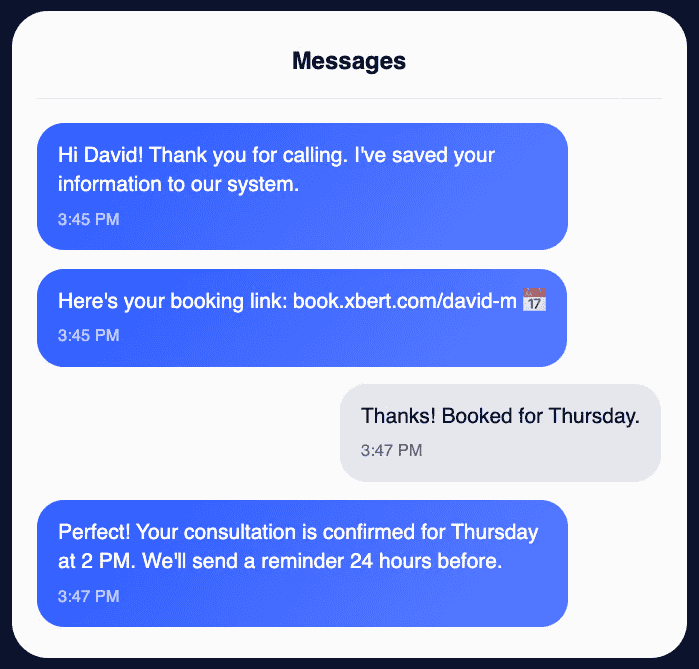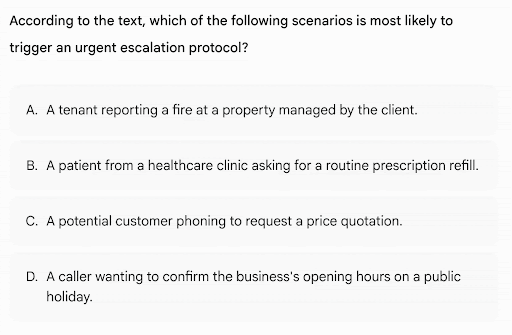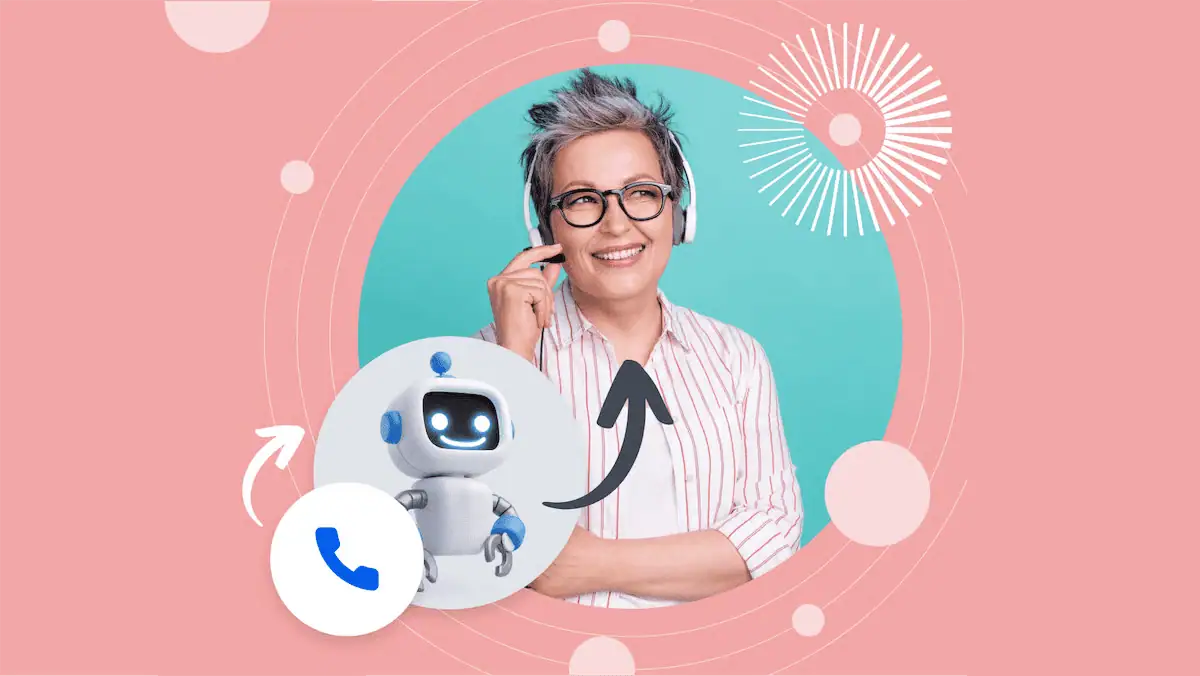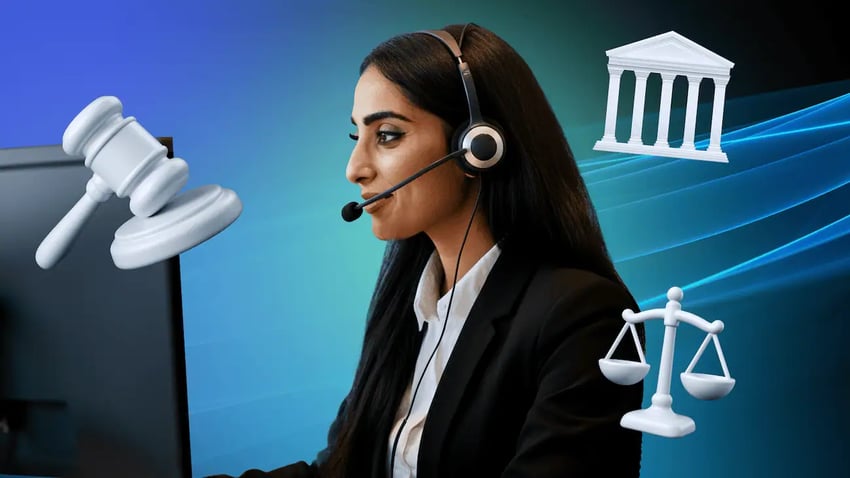Businesses don’t just miss calls after hours. They miss opportunities.
After-hours calls often end up in a voicemail box, a digital black hole where potential customers disappear. Studies show that 80% of callers who are sent to voicemail don’t leave a message.
AI receptionists solve this challenge. Still, the reality of how these after-hours answering services work is full of surprises that can directly impact your bottom line.
Far from being a simple automated menu, modern AI answering services are nuanced, powerful, and more accessible than you might think. For instance, consider Nextiva’s XBert AI’s intelligent routing mechanism.
Here’s a sneak peek into how Nextiva’s XBert AI takes a phone call after hours:
What Is an After-Hours Answering Service?
An after-hours answering service is a professional call-handling service that manages your business’s incoming calls outside of regular working hours. Whether it’s at night, on weekends, or during holidays, these services use either live agents or automated systems to ensure every call gets answered, even when your office is closed.
Instead of calls rolling over to voicemail, a real person or an intelligent virtual agent greets the customer and assists them. It keeps you responsive 24/7, so you don’t miss out on leads or let customers down because of limited business hours.
Call answering services perform a range of call-handling tasks to support your business, including:
- Answering and greeting callers
- Taking and forwarding messages
- Booking and rescheduling appointments
- Dispatching emergency calls
- Qualifying leads
- Handling FAQs and simple requests
All of these functions ensure your customers receive a consistent experience around the clock, regardless of their time zone.
Types of After-Hours Answering Services
After-hours answering services come in a few different types. The right choice depends on your business needs, budget, and preference for human vs. automated interaction.
Here are some of the main types.
Live virtual receptionists
Live virtual receptionist services use human receptionists who work remotely to handle your calls after hours. These trained agents answer incoming calls for multiple client businesses. They act as an extension of your brand, often following custom scripts you provide to greet callers and respond in your company’s tone.
It keeps the human touch intact while giving you opportunities to convey empathy and understand nuanced situations. Subsequently, you build rapport with callers.

When businesses have complex or sensitive inquiries, like in law firms or medical institutions, a live virtual receptionist delivers the personalized service needed. However, it comes with limitations:
- High cost: Since the service relies on human labor, it’s time-consuming and costly.
- Scalability: After a certain limit, scaling becomes challenging while maintaining a consistent experience.
AI virtual receptionists
AI virtual receptionists use conversational AI and speech recognition to handle calls. Instead of a human, a voice-based AI assistant greets callers. These systems are often built into modern business phone platforms and can integrate with your CRM or calendar. They automatically route inquiries, schedule appointments, answer FAQs, and take messages in real time, all without human intervention.
If 10 people call after hours simultaneously, an AI receptionist engages all 10 at once while delivering a consistent experience. The trade-off is that AI sometimes lacks a human’s emotional intuition.
That said, modern AI voices are increasingly lifelike, and you can train the system on your business knowledge to increase accuracy. These receptionists learn from past cases to deliver accepted solutions to complex queries. If something unique and critical comes up, the AI receptionist can transfer the call to a live agent in a hybrid setup.

Hybrid models
Hybrid answering service models combine live receptionists with AI systems to provide the best of both worlds. In a hybrid setup, an AI virtual receptionist handles routine phone calls and simple requests while humans manage more complex or sensitive calls.
For instance, your AI might answer the call, and if the caller says “I need to speak to someone about a complicated issue” or uses specific trigger phrases, the call is forwarded to an on-call human representative.
You benefit from AI cost savings and instant responses for most calls, but still have real people to step in when needed for high-touch service. It’s ideal if you want to provide a personal touch and handle high call volumes efficiently. Many small and midsized businesses see it as a way to ensure every call is answered appropriately without paying for an all-human 24/7 staff.
Call forwarding and auto attendants
Not every after-hours solution involves a live person or advanced AI. Some businesses opt for simpler call forwarding or auto-attendant setups. With call forwarding, you direct all after-hours calls to another phone line. The auto attendant greets callers with a recorded message and provides a menu of options. It can be configured to activate after business hours, providing self-service options to callers.

These solutions are typically low-cost and handle simple routing needs. For instance, a recording might inform the caller that your office is closed but offer the option to press 9 to reach the on-call emergency manager. However, these options provide no real engagement or lead capture. An auto attendant can’t answer questions or take a message beyond a generic voicemail. Callers who need help beyond the menu options may become frustrated or hang up.
These solutions are suitable for simple after-hours call routing but are limited in how they handle the calls.
Here’s a quick overview of different types of after-hours answering services:
| Service Type | Description | Benefits | Drawbacks |
|---|---|---|---|
| Live Virtual Receptionist | Real human receptionists answering calls remotely using your scripts. | More personalized service with human warmth and empathy. | The highest cost and limited scalability, as one live agent can only handle one call at a time. |
| AI Virtual Receptionist | An AI-powered assistant that answers calls with conversational AI. It’s excellent for high call volumes and routine inquiries. | 24/7 always-on availability. The system handles an unlimited number of calls simultaneously while delivering consistent responses. | Lacks human nuance for complex or emotional issues. It requires initial training on your business information. |
| Hybrid Model | A combination of AI and live agents. It’s useful for businesses needing both efficiency and a personal touch. | Offers human interaction when it matters and AI efficiency for everyday tasks. | Complexity in ensuring effective coordination between AI and humans. |
| Call Forwarding / Auto Attendant | Suitable for very simple needs or interim coverage. | Very low cost for simple routing needs. | No live interaction or real-time help. It cannot answer questions or actively capture leads. |
How After-Hours Answering Services Work
Here’s what happens when a customer calls at 9 p.m. or on business holidays. Most after-hours answering services follow a similar workflow with a few key components.
Call routing
Your incoming calls need to reach the after-hours service. This typically happens through call-forwarding rules. Businesses set up their phone system so that any call arriving after their regular closing time automatically forwards to the answering service. For example, if your business hours end at 6 p.m., you might configure that from 6 p.m. to 8 a.m., all calls go to the service’s phone number.
The transition is invisible to the caller. They dial your normal business number, but after hours, it rings at the service center or platform. Some services provide you with a dedicated number to transfer to, or you can integrate them directly via your VoIP provider.

Custom scripts or AI training
Once the call is answered, the service uses your instructions to handle it. Live receptionist services will have a custom script on file for your company. They become brand representatives, following your scripts and protocols to ensure consistent tone and accurate information.
In AI-based services, instead of a physical script, there is a knowledge base or training data specific to your business. During setup, you’ll provide details such as your business hours, product or service information, answers to common questions, and your preferred way to respond to inquiries. The AI is trained on this library of information, so it can automatically answer FAQs, provide prices, and use your company’s phrasing.
Be it human or AI, the service adapts to your brand voice and workflow to give a consistent experience to callers.
Lead capture and scheduling
After greeting the caller and understanding their needs, the phone answering service takes action to help the customer and capture important details.
In many cases, this means collecting the caller’s information and reason for calling, effectively capturing a lead or logging a support request. For example, if a potential customer calls for a quote after hours, the service will gather their name, their contact information, and the details of their request. All of that information is then passed to your team via email, a CRM entry, or an app for follow-up.
Many 24-hour answering services go a step further and handle on-the-spot appointment scheduling. With access to your calendar, an AI receptionist directly books an appointment or consultation for the caller while they’re on the line. This moves the customer further down the funnel by scheduling the next interaction. Some advanced AI systems even auto-populate your CRM with the call notes and set follow-up tasks.

Urgent escalation
Good answering services have protocols for urgent or emergency calls. Not every issue can wait until morning, and you may have certain situations that require an immediate alert.
If such a call comes in, the service will escalate according to your instructions; that might mean transferring the call to a specific on-call staff member’s phone or sending an instant notification to your on-call team with the caller’s details. For instance, a property management company might instruct the service to immediately forward any calls regarding flooding or fires to the on-call property manager.
The escalation path gives you peace of mind that critical calls won’t slip through the cracks. A health care clinic’s answering service might immediately alert the on-call doctor for symptoms like chest pain, but just take a message for routine prescription refill requests.

Reporting and analytics
All calls handled by the service are typically logged and tracked. You can expect to receive call summaries or to have access to an online dashboard with metrics such as the number of calls answered after hours, caller names and numbers, call times and durations, messages taken, appointments booked, etc.
Some services send a nightly or weekly report that summarizes everything. This data is more than just recordkeeping. It provides valuable insight into your customer service performance outside normal hours. Advanced AI-driven services even offer analytics on call trends, such as common call topics or frequently asked questions after hours.

These insights help you create more strategic documentation that can support customers after hours, just as you would.
Benefits of Using an After-Hours Answering Service
The upside of an after-hours answering service for your business is significant. Here are some of the key benefits:
- 24/7 availability: With an answering service covering your phones, your business becomes reachable day or night. Customers from any time zone or those who can only call outside of work hours will always find a responsive business instead of a dead line.
- Increased lead capture: Every after-hours call could be a potential new customer or revenue-generating opportunity. If those calls go unanswered, they can end up with your competitors. Using an after-hours answering service turns missed calls into captured leads.
- Improved customer satisfaction: Customers appreciate getting help when they need it. An after-hours answering service ensures that when someone calls with a question or issue, they receive assistance.
- Cost-effective coverage: Hiring employees or keeping staff on a night shift to answer phones can be prohibitively expensive for many small and midsized businesses. An after-hours answering service provides a far more cost-effective solution. You essentially outsource after-hours calls to an answering service, which can use live agents, AI, or a hybrid model.
- Emergency dispatch support: An after-hours answering service recognizes emergency keywords or situations and immediately contacts the on-call personnel you have designated. Customers get fast, appropriate help even in off hours, and your on-call team only gets alerted for genuine emergencies.
- Better brand consistency: When trained live agents or well-configured AI answer every call, using your approved greetings and information, you achieve a high level of brand consistency. No matter what time someone calls, they get the same tone, messaging, and professionalism.
How AI Is Redefining After-Hours Support
Traditional after-hours answering services have been around for decades, but now AI technology is rapidly transforming the service.
Here’s how AI-driven virtual receptionists, like Nextiva’s XBert AI, are taking things to a new level.
Always-on availability
Unlike humans, AI receptionists don’t need sleep, breaks, or shift changes. They can handle inquiries 24/7, covering nights, weekends, and holidays without any gaps.
For a business owner, this means you never have to worry about a call coming in at an odd hour. Some answering services may charge a higher rate on holidays. Make sure to verify this with the vendor before onboarding.
Intelligent context and routing
AI systems can interpret the caller’s intent from what they say. If the caller needs a specific department or person, the AI can route the call to the appropriate individual or team, including a summary of the issue. It essentially triages calls intelligently.
Additionally, AI receptionists capture and pass along essential details. They might note the urgency level or the caller’s intent explicitly when transferring. For example, XBert AI determines whether a call is sales, customer support, or an emergency and tags it accordingly. This means that when your on-call person or next-day team receives the handoff, they have the full context of what the caller needed, rather than just a generic message.

Integrated scheduling and CRM
An AI receptionist integrates with your business tools to make call handling and call management seamless. It connects with your Google Calendar, Outlook, or any scheduling system you use. When a customer wants to book an appointment or demo, the AI checks availability in real time and reserves a slot on the calendar right then and there. The service automatically sends a confirmation email or SMS to the caller.
This eliminates the back-and-forth of manual scheduling and ensures appointments aren’t missed. Similarly, AI receptionists connect with CRM systems and other databases. As they gather caller information, they instantly log a new contact or update an existing record in your CRM. This helps you maintain a single source of truth to drive insights.
Natural conversations
One of the most significant leaps with AI receptionists is how natural and human-like the interactions have become. XBert AI uses advanced text-to-speech and voice recognition technology to sound remarkably lifelike. You can also customize the scripts and vocabulary so they use phrasing that fits your brand or industry.
Callers can speak in their own words, and the AI will understand and respond appropriately. This makes the experience more conversational and less frustrating for callers.
How to Choose the Right After-Hours Answering Service
Not all services are the same, and the best choice depends on your specific needs. Here are key factors and criteria to consider when choosing an after-hours answering service for your business.
Coverage model
Decide what coverage model fits your business: live agents, AI, or a hybrid. Each model has trade-offs in cost, customer experience, and capabilities. If your inbound calls tend to be straightforward and you’re cost-sensitive, an AI-only solution might be enough.
If you handle highly sensitive or complex calls where empathy and judgment are critical, you may lean toward live human agents despite the higher cost. A hybrid model can be a great middle ground.
In a typical hybrid workflow, the AI fields routine calls and simple requests, such as answering frequently asked questions or booking standard appointments. However, when a call becomes more complex, it’s seamlessly escalated to a human agent. This positions the hybrid model as a form of strategic risk management.
It mitigates the brand damage of a purely AI system failing in a sensitive customer interaction while capturing the cost-efficiency of automation for routine tasks.
Industry specialization
Consider whether a provider has experience or features tailored to your industry. Some telephone answering services specialize in specific verticals, which can be a big plus. For example, a service focused on medical or health care will be HIPAA-compliant and familiar with medical terminology and protocols.
Even an AI receptionist can be tuned to industry specifics if the provider has a library of relevant knowledge. This helps you ensure better-quality interactions.

Integration capabilities
A reliable service will connect with your CRM, customer database, helpdesk, scheduling calendar, or other tools. It keeps the information flow smooth. For instance, Nextiva’s XBert AI receptionist syncs with the Nextiva platform and CRMs to log interactions automatically. When comparing options, look for mentions of integrations with platforms you use or direct integrations with industry-specific software.
Scalability
You want a service that can scale with your growth or seasonal spikes. If you expect your business to expand, ensure the provider can handle that. AI-based services are inherently scalable, so they’re a safe bet for growing companies or unpredictable volumes.
But if you’re using a live call answering service, ask how they handle high call volumes. Ask these questions to get more clarity:
- Do you have enough operators?
- Will callers ever be placed on hold or sent to voicemail if all agents are busy?
- How will you handle simultaneous call overflows?
Customization
Look at what level of customization a provider offers. The best services will take time to properly onboard you. For example, an AI service might let you upload FAQs and price lists and even choose the AI’s voice.
You should be able to dictate how messages are taken, how names are pronounced, what constitutes an emergency, etc.
Analytics and reporting
Many good services offer a client portal where you can view call logs, listen to call recordings or voicemails, and see statistics such as how many calls were answered, average call length, etc. These reports are not just nice-to-haves; they let you verify the service’s performance and calculate your ROI.
If you’re leaning toward an AI solution, check whether it includes built-in analytics dashboards. Nextiva, for instance, offers dashboards for after-hours call activity.
At a minimum, you want to know call volume, outcomes, and any missed calls. Also, consider metrics like first-call resolution or customer satisfaction, even if they’re measured via follow-ups.

Cost and ROI
You’ll want to weigh the service’s cost against its benefits. A cheaper service might limit features or have fewer trained agents, whereas a premium service might justify a higher price with better quality or advanced AI. A testimonial for Nextiva’s XBert AI provides a powerful, data-backed example of the ROI.

Nextiva provides an AI receptionist ROI calculator that lets you plug in your missed call rates, lead conversion rates, etc., to estimate the revenue you can potentially generate.

Look out for these when considering cost
While considering the cost of an answering service, it’s also essential to check how the service handles spam after hours. Some businesses automatically flag spam or sales calls, or don’t charge if the call is less than 10 or 15 seconds.
Many AI receptionist services that charge by the minute may come with hidden costs. These services often sell bundles of minutes, and business owners may be shocked to discover where those minutes are actually going. Spam calls and robocallers consume these. You may be able to add a basic IVR menu at the beginning of the call, where the caller must press a button to continue, protecting your answering service minutes against spam calls.
Common questions about the after-hours answering service
While comparing your options, you might wonder:
What are the typical price ranges of an after-hours answering service?
A professional answering service’s costs depend on call volume, features required, and pricing model. It typically ranges from $95 to $1,200 or more per month. Basic services with limited minutes typically start at around $100 per month, while comprehensive packages with 24/7 support and advanced features can exceed $1,000 per month for businesses with high call volumes.
Nextiva AI starts at $99/month.

How difficult is it to set up and integrate an AI or hybrid answering service with my current phone system?
After-hours answering setup depends on how effectively the system of your choice connects with the rest of your business apps and phone system. Products like Nextiva have native integrations to relevant and popular apps, making it quick to onboard and get started. Most businesses go live in under three minutes.
XBert AI automatically gathers insights from your website and existing information. The Nextiva team offers a complimentary assisted setup to guarantee top performance from the very start.
Here’s what you get with Nextiva XBert AI:

How much control do I have over scripts, responses, and escalation protocols with these services?
With XBert AI, you have granular control over these. You can choose from multiple AI voice options, customize greetings, define call routing rules, and adjust response behavior, all in real time through your dashboard, without technical expertise.
How quickly can I expect to see a return on my investment after implementing an after-hours answering service?
You can use the AI receptionist calculator to get a sense of ROI from the platform.
Don’t Let Incoming Calls Slip Away: The Case for Nextiva’s XBert AI
Nextiva’s XBert AI delivers always-on availability without adding overhead or burning out your staff.
Businesses that have adopted AI receptionists early are seeing tangible benefits in the form of:
- Faster response times to inquiries
- Improved customer satisfaction
- Higher revenue per lead
Nextiva’s XBert AI provides proactive and intelligent engagement at all hours, ensuring your incoming calls don’t slip away. One user says, “XBert AI paid for itself in the first week. One saved client call covered the cost of the whole month.”
Before you commit, consider a quick self-assessment: Count the number of missed calls your business had last week. If you could, wouldn’t you take up these missed opportunities?
Don’t let another after-hours call go unanswered. Try Nextiva’s XBert AI.
Your AI receptionist that never misses a call.
XBert is your AI answering service that handles calls, texts, and chats 24/7. It greets customers, books appointments, and captures leads while your business grows.

















 Customer Experience
Customer Experience 









